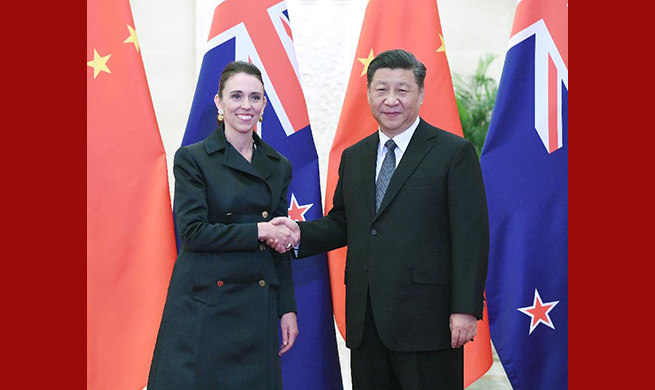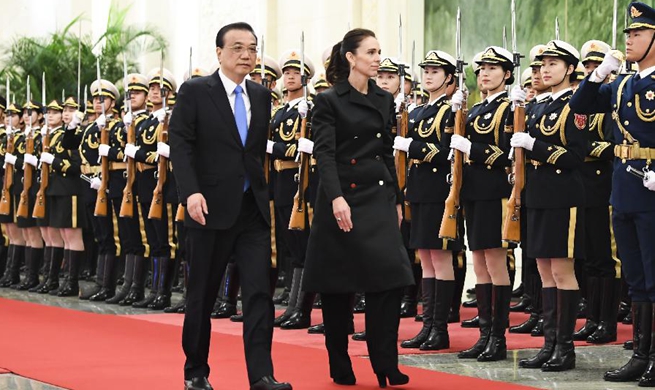WASHINGTON, April 2 (Xinhua) -- The Bloomberg Barclays Global Aggregate Index started including China's yuan-demoninated bonds Monday, with a 20-month phase-in period.
The inclusion of the 356 bonds, issued by the government and policy banks, in the index is expected to attract foreign inflows into the Chinese bond market and foster a further opening-up of the country's financial sector.
FOREIGN INFLOWS
After their full inclusion, Chinese renminbi (RMB)-denominated bonds will become the fourth-largest currency component, following the U.S. dollar, the euro and the Japanese yen. China's weight would reach approximately 6 percent of the index, using data as of Jan. 31 this year.
"It will effectively lead to more purchases of Chinese bonds by foreigners and provide investors globally with an opportunity to diversify their assets," Alfred Schipke, the International Monetary Fund (IMF) senior resident representative for China, told Xinhua in a recent interview.
Goldman Sachs estimated in February that total inflows into China's bond market prompted by this inclusion would be 120-135 billion U.S. dollars over the 20-month scale-in period.
Morgan Stanley, meanwhile, expects to see 80-100 billion dollars of inflows into the government bond market in 2019, compared to 35 billion dollars on average between 2015 and 2018.
It sees as much as 120 billion dollars going into China's government bond market annually from 2020 to 2030, according to a February report.
China's bond market stood at about 86 trillion yuan (12.84 trillion dollars) by the end of 2018, with about 1.8 trillion yuan (260 billion dollars), or 2 percent, held by global investors, up 46 percent from a year earlier, according to the People's Bank of China.
Deutsche Bank's projections suggest that foreigners will own as much as a fifth of central government debt in five years, Bloomberg reported last week.
An expected growth in inflows will make the foreign investor community "an increasingly significant stakeholder" in China's financial system, Bloomberg said.
IMPORTANT MILESTONE
The inclusion is an "important milestone" in China's financial integration into the world economy, said Changyong Rhee, director of the IMF's Asia and Pacific Department, at a book forum held in Washington D.C. in March.
"This development follows the establishment in 2017 of the so-called Bond Connect, which allows foreigners to enter the Chinese bond market, as well as the authorities' recent commitments to further develop and open the market," Rhee said in his opening remarks at the event.
According to a government work report delivered in early March, China will implement reform and opening-up measures in the financial sectors and improve policies on opening the bond market.
Schipke noted that the inclusion of the renminbi (RMB) in the Special Drawing Rights (SDR) basket in November 2016 was associated with operational improvements in China's bond market, which has triggered a surge in global investor interest.
"More foreign central banks and sovereign wealth funds have bought RMB bonds as part of their reserves," he said, as holdings of RMB reserves by foreign central banks have gone up about 100 percent since 2016.
Citing the "co-movement" of the RMB with other currencies in the world, Schipke said the international monetary system might be moving away from the bipolar U.S. dollar and the euro blocs to a tripolar system. "That probably means that there will be additional demand for RMB bonds," he said.
China's bond market, the third largest in the world, is reaching a "tipping point" as regulation, market access, investor demand and benchmarks are firmly in place, Li Bing, head of Bloomberg China, said in a statement.
China's inclusion in the index has been a journey as financial reforms deepen and as its capital markets become more transparent to global investors, Li said.
FURTHER OPENING-UP
Bloomberg suggested China enhance market liquidity, improve its rating system, increase hedging tools and address operational concerns in order to promote the healthy development of China's bond market, Li said.
As foreign rating agencies start operating in the Chinese bond market, its rating system has to improve to meet global standards, Li said, adding that it is critical for the next evolution of China's corporate bond inclusion into the Bloomberg Barclays index.
Bloomberg found it "encouraging" to hear that a key task for the People's Bank of China this year is to provide sufficient financial hedging instruments to allow investors to effectively manage risks, Li said.
Goldman Sachs thinks that the operational issues should improve over time as teething issues are addressed during the phased inclusion, which should pave the way for other bond indices to include China.
Two other major global bond indices include the FTSE World Government Bond Index and the J.P. Morgan Government Bond Index-Emerging Markets.
"We expect all three major bond indices to include China (or at least announcement of plans to include China) by the end of 2020," Goldman Sachs said in the February report.
Schipke, one of the editors of the book "The Future of China's Bond Market" published by the IMF in March, said the team thinks that China's financial sector integration in the next decade will bring many opportunities for investors globally to diversify their portfolios.
Looking ahead, the book's contributors believe that a careful sequencing of reforms could help minimize risks and promote the development of China's bond market. The team suggested that China strengthen the capacity of financial regulators, boost foreign participation and improve communication, among other things.
"It is important to further the quantity of information that is available for investors," Schipke said, adding that more transparency should be conducive to the development of China's bond market.
"Last year China celebrated its 40th anniversary of reform and opening-up, which contributed to China's trade and product integration," said Schipke.
"But if you're looking at the future, our view is that the future will be about China's financial sector integration with the world and the bond market will play a particular role," he said.












